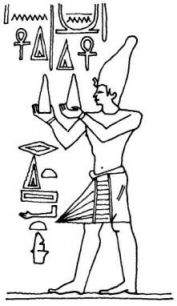Doorways

She continues...
"In Greek mythology the quest for the secret of this substance was at the heart of the Golden Fleece legend, while in biblical terms it was the mystical realm of the Ark of the Covenant - the golden coffer which Moses brought out of Sinai, to be housed in the Temple of Jerusalem. The ancient Mesopotamians called the powder 'shem-an-na' (highward fire-stone) and the Egyptians described it as 'mfkzt', while the Alexandrians venerated it as the Paradise Stone.
Made into conical cakes, or suspended in water, the enigmatic fire-stone powder was a ritually ingested supplement of the ancient kings and pharaohs. It was revered as the food of the 'light body' (the ka) and was reckoned to heighten general aptitudes of leadership, such as awareness, perception and intuition. It was further considered to be a key to active longevity.
The 17th-century philosopher, Eirenaeus Philalethes (revered by Isaac Newton, Robert Boyle, Elias Ashmole and other Royal Society colleagues of his era), produced a work in 1667 entitled 'Secrets Revealed'. In this treatise he discussed the nature of the Philosophers' Stone, which was commonly thought to transmute base metal into gold.
Setting the record straight, Philalethes made the point that the Stone was itself made from gold, and that the philosopher's art was in perfecting this process. He stated: "Our Stone is nothing but gold digested to the highest degree of purity and subtle fixation. It is called a stone by virtue of its fixed nature; it resists the action of fire as successfully as any stone. In species it is gold, more pure than the purest; it is fixed and incombustible like a stone, but its appearance is that of a very fine powder."
Some time earlier, in 1416, the noted French chemist Nicolas Flamel wrote that when the noble metal was perfectly prepared, it made a fine 'powder of gold', which is the Philosophers' Stone.
This substance once called the 'powder of projection' could be a very dangerous weapon if it fell into the wrong hands."
"In Greek mythology the quest for the secret of this substance was at the heart of the Golden Fleece legend, while in biblical terms it was the mystical realm of the Ark of the Covenant - the golden coffer which Moses brought out of Sinai, to be housed in the Temple of Jerusalem. The ancient Mesopotamians called the powder 'shem-an-na' (highward fire-stone) and the Egyptians described it as 'mfkzt', while the Alexandrians venerated it as the Paradise Stone.
Made into conical cakes, or suspended in water, the enigmatic fire-stone powder was a ritually ingested supplement of the ancient kings and pharaohs. It was revered as the food of the 'light body' (the ka) and was reckoned to heighten general aptitudes of leadership, such as awareness, perception and intuition. It was further considered to be a key to active longevity.
The 17th-century philosopher, Eirenaeus Philalethes (revered by Isaac Newton, Robert Boyle, Elias Ashmole and other Royal Society colleagues of his era), produced a work in 1667 entitled 'Secrets Revealed'. In this treatise he discussed the nature of the Philosophers' Stone, which was commonly thought to transmute base metal into gold.
Setting the record straight, Philalethes made the point that the Stone was itself made from gold, and that the philosopher's art was in perfecting this process. He stated: "Our Stone is nothing but gold digested to the highest degree of purity and subtle fixation. It is called a stone by virtue of its fixed nature; it resists the action of fire as successfully as any stone. In species it is gold, more pure than the purest; it is fixed and incombustible like a stone, but its appearance is that of a very fine powder."
Some time earlier, in 1416, the noted French chemist Nicolas Flamel wrote that when the noble metal was perfectly prepared, it made a fine 'powder of gold', which is the Philosophers' Stone.
This substance once called the 'powder of projection' could be a very dangerous weapon if it fell into the wrong hands."
